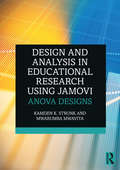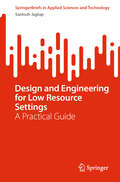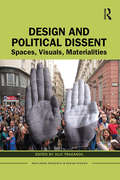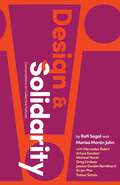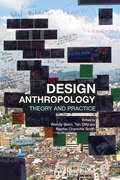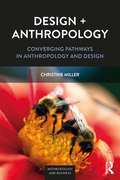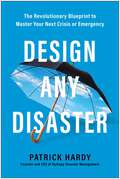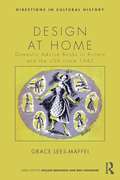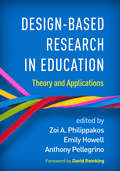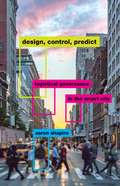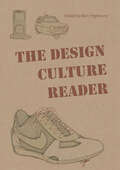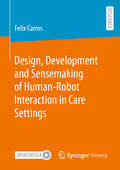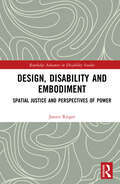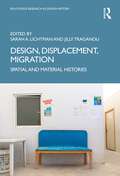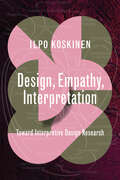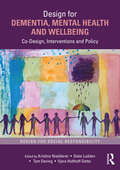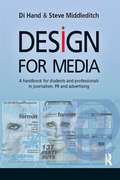- Table View
- List View
Design and Analysis in Educational Research Using jamovi: ANOVA Designs
by Kamden K. Strunk Mwarumba MwavitaDesign and Analysis in Educational Research Using jamovi is an integrated approach to learning about research design alongside statistical analysis concepts. Strunk and Mwavita maintain a focus on applied educational research throughout the text, with practical tips and advice on how to do high-quality quantitative research. Based on their successful SPSS version of the book, the authors focus on using jamovi in this version due to its accessibility as open source software, and ease of use. The book teaches research design (including epistemology, research ethics, forming research questions, quantitative design, sampling methodologies, and design assumptions) and introductory statistical concepts (including descriptive statistics, probability theory, sampling distributions), basic statistical tests (like z and t), and ANOVA designs, including more advanced designs like the factorial ANOVA and mixed ANOVA. This textbook is tailor-made for first-level doctoral courses in research design and analysis. It will also be of interest to graduate students in education and educational research. The book includes Support Material with downloadable data sets, and new case study material from the authors for teaching on race, racism, and Black Lives Matter, available at www.routledge.com/9780367723088.
Design and Analysis in Quantitative Educational Research: Univariate Designs in SPSS
by Kamden K. Strunk Mwarumba MwavitaDesign and Analysis in Quantitative Educational Research: Univariate Designs in SPSS presents an integrated approach to learning about research design alongside statistical analysis concepts. The authors maintain a focus on applied educational research throughout the text, with practical tips and advice on how to do high-quality quantitative research.This book teaches research design (including epistemology, research ethics, forming research questions, quantitative design, sampling methodologies, and design assumptions) and introductory statistical concepts (including descriptive statistics, probability theory, and sampling distributions), basic statistical tests (like z and t), ANOVA designs, including more advanced designs like the factorial ANOVA and mixed ANOVA, simple linear regression, and multiple regression using SPSS for analysis. Designed specifically for an introductory graduate course in research design and statistical analysis, the book takes students through principles by presenting case studies, describing the research design principles at play in each study, and then asking students to walk through the process of analyzing data that reproduce the published results. The new edition has been updated to include the latest contemporary research developments, coverage of IBM SPSS Statistics version 29, and also features new case studies, many focused on race and racism as well as other equity and justice work, and additional content on covariance and correlation. An online eResource is also available with data sets.This textbook is tailor-made for first-level doctoral courses in research design and analysis, and will also be of interest to graduate students in education and educational research.
Design and Anthropology: Theory And Practice (Anthropological Studies of Creativity and Perception)
by Wendy Gunn Jared DonovanDesign and Anthropology challenges conventional thinking regarding the nature of design and creativity, in a way that acknowledges the improvisatory skills and perceptual acuity of people. Combining theoretical investigations and documentation of practice based experiments, it addresses methodological questions concerning the re-conceptualisation of the relation between design and use from both theoretical and practice-based positions. Concerned with what it means to draw 'users' into processes of designing and producing this book emphasises the creativity of design and the emergence of objects in social situations and collaborative endeavours. Organised around the themes of perception and the user-producer, skilled practices of designing and using, and the relation between people and things, the book contains the latest work of researchers from academia and industry, to enhance our understanding of ethnographic practice and develop a research agenda for the emergent field of design anthropology. Drawing together work from anthropologists, philosophers, designers, engineers, scholars of innovation and theatre practitioners, Design and Anthropology will appeal to anthropologists and to those working in the fields of design and innovation, and the philosophy of technology and engineering.
Design and Engineering for Low Resource Settings: A Practical Guide (SpringerBriefs in Applied Sciences and Technology)
by Santosh JagtapThis book provides an integrated and practical methodology aimed at designing, developing, and implementing holistic solutions for the betterment of people living in low resource settings within developing nations. These people confront a multitude of challenges at individual, institutional, economic, and technological levels. Consequently, integrated solutions are necessary to satisfy their unmet or underserved needs effectively. Using a comprehensive approach, this book offers a systematic methodology for designing such integrated solutions, supplemented by case studies and actionable guidelines. Outstanding features of the book include: An integrated methodology and guidelines for designing, developing, and implementing holistic solutions to support development of resource-constrained societies. The guidelines cover phases in the design process such as understanding context and needs, concept exploration and detailing, and implementation. Case studies illustrate each guideline. Visual illustrations for easy understanding of the guidelines. Actionable methods and strategies for applying the integrated methodology and guidelines in projects. Practitioners, students, and researchers, interested in the sustainable development of low resource settings, will find this book motivating and practical.
Design and Political Dissent: Spaces, Visuals, Materialities (Routledge Research in Design Studies)
by Jilly TraganouThis book examines, through an interdisciplinary lens, the relationship between political dissent and processes of designing. In the past twenty years, theorists of social movements have noted a diversity of visual and performative manifestations taking place in protest, while the fields of design, broadly defined, have been characterized by a growing interest in activism. The book’s premise stems from the recognition that material engagement and artifacts have the capacity to articulate political arguments or establish positions of disagreement. Its contributors look at a wide array of material practices generated by both professional and nonprofessional design actors around the globe, exploring case studies that vary from street protests and encampments to design pedagogy and community-empowerment projects. For students and scholars of design studies, urbanism, visual culture, politics, and social movements, this book opens up new perspectives on design and its place in contemporary politics.
Design and Solidarity: Conversations on Collective Futures
by Rafi Segal Marisa Morán JahnIn times of crisis, mutual aid becomes paramount. Even before the COVID-19 pandemic, new forms of sharing had gained momentum to redress precarity and stark economic inequality. Today, a diverse array of mutualistic organizations seek to fundamentally restructure housing, care, labor, food, and more. Yet design, art, and architecture play a key role in shaping these initiatives, fulfilling their promise of solidarity, and ensuring that these values endure.In this book, artist Marisa Morán Jahn and architect Rafi Segal converse about the transformative potential of mutualism and design with leading thinkers and practitioners: Mercedes Bidart, Arturo Escobar, Michael Hardt, Greg Lindsay, Jessica Gordon Nembhard, Ai-jen Poo, and Trebor Scholz. Together, they consider how design inspires, invigorates, and sustains contemporary forms of mutualism—including platform cooperatives, digital-first communities, emerging currencies, mutual aid, care networks, social-change movements, and more. From these dialogues emerge powerful visions of futures guided by communal self-determination and collective well-being.
Design Anthropological Futures: Exploring Emergence, Intervention And Formation (Criminal Practice Ser.)
by Rachel Charlotte Smith Kasper Tang Vangkilde Mette Gislev Kjærsgaard Ton Otto Joachim Halse Thomas BinderA major contribution to the field, this ground-breaking book explores design anthropology’s focus on futures and future-making. Examining what design anthropology is and what it is becoming, the authors push the frontiers of the discipline and reveal both the challenges for and the potential of this rapidly growing transdisciplinary field.Divided into four sections – Ethnographies of the Possible, Interventionist Speculation, Collaborative Formation of Issues, and Engaging Things – the book develops readers’ understanding of the central theoretical and methodological aspects of future knowledge production in design anthropology. Bringing together renowned scholars such as George Marcus and Alison Clarke with young experimental design anthropologists from countries such as Denmark, Sweden, Austria, Brazil, the UK, and the United States, the sixteen chapters offer an unparalleled breadth of theoretical reflections and rich empirical case studies.Written by those at the forefront of the field, Design Anthropological Futures is destined to become a defining text for this growing discipline. A unique resource for students, scholars, and practitioners in design anthropology, design, architecture, material culture studies, and related fields.
Design Anthropology: Theory and Practice (Criminal Practice Ser.)
by Wendy Gunn Ton Otto Rachel Charlotte SmithDesign is a key site of cultural production and change in contemporary society. Anthropologists have been involved in design projects for several decades but only recently a new field of inquiry has emerged which aims to integrate the strengths of design thinking and anthropological research.This book is written by anthropologists who actively participate in the development of design anthropology. Comprising both cutting-edge explorations and theoretical reflections, it provides a much-needed introduction to the concepts, methods, practices and challenges of the new field. Design Anthropology moves from observation and interpretation to collaboration, intervention and co-creation. Its practitioners participate in multidisciplinary design teams working towards concrete solutions for problems that are sometimes ill-defined. The authors address the critical potential of design anthropology in a wide range of design activities across the globe and query the impact of design on the discipline of anthropology.This volume will appeal to new and experienced practitioners in the field as well as to students of anthropology, innovation, science and technology studies, and a wide range of design studies focusing on user participation, innovation, and collaborative research.
Design + Anthropology: Converging Pathways in Anthropology and Design (Anthropology & Business)
by Christine MillerThis book explores the evolution of two disciplines, design and anthropology, and their convergence within commercial and organizational arenas. Focusing on the transdisciplinary field of design anthropology, the chapters cover the global forces and conditions that facilitated its emergence, the people that have contributed to its development and those who are likely to shape its future. Christine Miller touches on the invention and diffusion of new practices, the recontextualization of ethnographic inquiry within design and innovations in applications of anthropological theory and methodology. She considers how encounters between anthropology and ‘designerly’ practice have impacted the evolution of both disciplines. The book provides students, scholars and practitioners with valuable insight into the movement to formalize the nascent field of design anthropology and how the relationship between the two fields might develop in the future given the dynamic global forces that continue to impact them both.
Design Anthropology in Context: An Introduction to Design Materiality and Collaborative Thinking
by Adam DrazinThis book explores the broad territory of design anthropology, covering key approaches, ways of working and areas of debate and tension. It understands design as fundamentally human centred and argues for a design anthropology based primarily on collaboration and communication. Adam Drazin suggests the most important collaborative knowledges which design anthropology develops are heuristic, emerging as engagements between fieldwork sites and design studios. The chapters draw on material culture literature and include a wide range of examples of different projects and outputs. Highlighting the importance of design as a topic in the study of contemporary culture, this is valuable reading for students and scholars of anthropology and design as well as practitioners.
Design Any Disaster: The Revolutionary Blueprint to Master Your Next Crisis or Emergency
by Patrick HardyNever experience a disaster again—ever. Hurricanes, wildfires, mass shootings, and pandemics are a reality for 21st century families and small businesses. But here&’s the truth: Not one of these has to be a disaster. What determines whether an unexpected event becomes a disaster is you. In Design Any Disaster, certified emergency manager and master business continuity practitioner Patrick Hardy reveals to you the secrets of disaster preparedness that helped him build the largest and most successful small business and family disaster planning company in the world. He explains why: You should never, ever &“remain calm&” during a disaster. 99% of all disaster plans are a complete waste of time. Fancy disaster equipment and supplies actually leave you less prepared. Design Any Disaster is not a survival manual. It&’s a revolutionary approach to disaster preparedness, response, and recovery for families and small businesses that can be used whether you live in the middle of a big city, in a quiet suburban neighborhood, or in a rural county with more cows than people. Using the powerful C3 Method Hardy uses with his clients, from Fortune 500 CEOs to average families, you will discover how to get ready (plan effectively), react (focus without panicking), respond (protect yourself and your possessions), and recover (overcome swiftly). And in a revolutionary section you will not find in any other disaster book, Hardy also reveals how to reverse disaster, converting the experience into an opportunity to become wiser and happier. Control the disaster so that it doesn&’t control you—that&’s how you Design Any Disaster.
Design at Home: Domestic Advice Books in Britain and the USA since 1945 (Directions In Cultural History Ser.)
by Grace Lees MaffeiDomestic advice literature is rich in information about design, ideals of domesticity, consumption and issues of identity, yet this literature remains a relatively neglected resource in comparison with magazines and film. Design at Home brings together etiquette, homemaking and home decoration advice as sources in the first systematic demonstration of the historical value of domestic advice literature as a genre of word and image, and a discourse of dominance. This book traces a transatlantic domestic dialogue between the UK and the US as the chapters explore issues of design, domesticity, consumption, social interaction and identity markers including class, gender and age. Areas covered include: • the use of domestic advice by historians • relationships between advice, housing and the middle class • links between advice and gender • advice and the teenage consumer Design at Home is essential reading for students and scholars of cultural and social history, design history, and cultural studies.
Design-Based Research in Education: Theory and Applications
by Zoi A. Philippakos, Emily Howell and Anthony PellegrinoEffective research in educational settings requires collaboration between researchers and school-based practitioners to codesign instruction and assessment, analyze findings to inform subsequent iterations, and make thoughtful revisions. This innovative reference and course text examines the theory and practice of design-based research (DBR), an important methodology for conducting studies in authentic educational contexts. Leading experts provide specific examples of high-quality DBR addressing different research foci, grade levels, and subject areas (literacy/English language arts, math, and science). Applications are presented for curriculum development, intervention, assessment, and digital contexts, as well as teaching second-language learners. Also addressed is DBR&’s role in educator preparation, professional development, dissertation research, and technical education.
Design, Control, Predict: Logistical Governance in the Smart City
by Aaron ShapiroAn in-depth look at life in the &“smart&” city Technology has fundamentally transformed urban life. But today&’s &“smart&” cities look little like what experts had predicted. Aaron Shapiro shows us the true face of the revolution in urban technology, taking the reader on a tour of today&’s smart city. Along the way, he develops a new lens for interpreting urban technologies—logistical governance—to critique an urban future based on extraction and rationalization. Through ethnographic research, journalistic interviews, and his own hands-on experience, Shapiro helps us peer through cracks in the smart city&’s facade. He investigates the true price New Yorkers pay for &“free,&” ad-funded WiFi, finding that it ultimately serves the ends of commercial media. He also builds on his experience as a bike courier for a food delivery startup to examine how promises of &“flexible employment&” in the gig economy in fact pave the way for strict managerial control. And he turns his eye toward hot-button debates around police violence and new patrol technologies, asking whether algorithms are really the answer to reforming our cities&’ ongoing crises of criminal justice. Through these gripping accounts of the new technological urbanism, Design, Control, Predict makes vital contributions to conversations around data privacy and algorithmic governance. Shapiro brings much-needed empirical research to a field that has often relied on &“10,000-foot views.&” Timely, important, and expertly researched, Design, Control, Predict doesn&’t just help us comprehend urbanism today—it advances strategies for critiquing and resisting a dystopian future that can seem inevitable.
The Design Culture Reader
by Ben HighmoreDesign is part of ordinary, everyday life, to be found in every room in every building in the world. While we may tend to think of design in terms of highly desirable objects, this book encourages us to think about design as ubiquitous (from plumbing to television) and as an agent of social change (from telephones to weapon systems).The Design Culture Reader brings together an international array of writers whose work is of central importance for thinking about design culture in the past, present and future. Essays from philosophers, media and cultural theorists, historians of design, anthropologists, cultural historians, artists and literary critics all demonstrate the enormous potential of design studies for understanding the modern world. Organised in thematic sections, The Design Culture Reader explores the social role of design by looking at the impact it has in a number of areas �€“ especially globalisation, ecology, and the changing experiences of modern life. Particular essays focus on topics such as design and the senses, design and war and design and technology, while the editor's introduction to the collection provides a compelling argument for situating design studies at the very forefront of contemporary thought.
Design, Development and Sensemaking of Human-Robot Interaction in Care Settings
by Felix CarrosSocial robots have significantly advanced in capabilities and availability, gradually becoming part of everyday life. Their new interactive features are relevant to the struggling care sector. As Western societies age, the demand for care services rises, yet the workforce does not grow at the same rate. This book explores the potential of social robots to support the workforce and enhance the well-being of residents in care homes. Using a socio-informatics approach, this research investigates how residents and caregivers interact with social robots, examines and facilitates their appropriation, and provides insights into the development of the robots' software and hardware. The research and development were carried out collaboratively in care homes with the people who work and live there. The findings indicate that social robots can be beneficial in care homes. They broaden the options for social care workers and, when integrated into daily routines, can provide brief respite periods. Additionally, they positively impact residents by engaging them in cognitive and physical activities. However, the robots can only assist, and not replace, care workers.
Design, Disability and Embodiment: Spatial Justice and Perspectives of Power (Routledge Advances in Disability Studies)
by Janice RiegerThis timely book explores the spatial and social injustices within our streets, malls, schools, and public institutions. Taken-for-granted acts like going for a walk, seeing an exhibition with a friend, and going to school are, for people with disabilities, conditional or precluded acts due to exclusion by design. This book stimulates debate and discussion about current practice and studies in spatial design in the context of disability and the growing need for inclusive design globally. Case studies of inclusive design in spaces like museums, malls, galleries and universities are presented to challenge and expose the perspectives of power and spatial injustices that still exist within these spaces today. The international case studies presented purposely privilege the voices and perspectives of people with disabilities, to expose the multisensorial perspectives of spatial justice in order to understand inclusion more holistically through embodiment. If you are an architect, designer, arts educator, curator or museum professional or just want a world where spatial justice is possible, then this book will provide you with a new perspective of spatial design through critical disability studies, allyship and codesign, where tangible approaches and practices for inclusive design are explored.
Design, Displacement, Migration: Spatial and Material Histories (Routledge Research in Design History)
by Sarah A. LichtmanDesign, Displacement, Migration: Spatial and Material Histories gathers a collection of scholarly and creative voices—spanning design, art, and architectural history; design studies; curation; poetry; activism; and social sciences––to interrogate the intersections of design and displacement. The contributors foreground objects, spaces, visual, and material practices and consider design’s role in the empire, the state, and various colonizing regimes in controlling the mass movement of people, things, and ideas across borders, as well as in social acts that resist forced mobility and immobility, or enact new possibilities. By consciously surfacing echoes, rhymes, and dissonances among varied histories, this volume highlights local specificity while also accounting for the vectors of displacement and design across borders and histories. Design, Displacement, Migration: Spatial and Material Histories shows displacement to be a lens for understanding space and materiality and vice versa, particularly within the context of modernity and colonialism. This book will be of interest to scholars working in design history, design studies, architectural history, art history, urban studies, and migration studies.
Design Economies and the Changing World Economy: Innovation, Production and Competitiveness (Routledge Studies in Human Geography)
by John R. Bryson Grete RustenDesign is central to every service or good produced, sold and consumed. Manufacturing and service companies located in high cost locations increasingly find it difficult to compete with producers located in countries such as India and China. Companies in high-cost locations either have to shift production abroad or create competitive advantage through design, innovation, brand and the geographic distribution of tasks rather than price. Design Economies and the Changing World Economy provides the first comprehensive account of the relationship between innovation, design, corporate competitiveness and place. Design economies are explored through an analysis of corporate strategies, the relationship between product and designer, copying and imitation including nefarious learning, design and competitiveness, and design-centred regional policies. The design process plays a critical role in corporate competitiveness as it functions at the intersection between production and consumption and the interface between consumer behaviour and the development and design of products. This book focuses on firms, individuals, as well as national policy, drawing attention to the development of corporate and nation based design strategies that are intended to enhance competitive advantage. Increasingly products are designed in one location and made in another. This separation of design from the place of production highlights the continued development of the international division of labour as tasks are distributed in different places, but blended together to produce design-intensive branded products. This book provides a distinctive analysis of the ways in which companies located in developed market economies compete on the basis of design, brand and the geographic distribution of tasks. The text contains case studies of major manufacturing and service companies and will be of valuable interest to students and researchers interested in Geography, Economics and Planning.
Design, Empathy, Interpretation: Toward Interpretive Design Research (Design Thinking, Design Theory)
by Ilpo KoskinenA new, empathic approach to design research, drawn from the informed experiences of a leading design research program in Finland.Design, Empathy, Interpretation tells the story of empathic design, a design research program at Aalto University in Helsinki, Finland, that has developed an interpretive approach to design over the past twenty years. As one of the leaders of the Helsinki group, Ilpo Koskinen draws on his own experiences to offer readers a general intellectual and professional history of design research, and argues for what he calls an interpretive approach. Design, Empathy, Interpretation shows how the group has created connections all across the globe, and how a seemingly soft approach to design research can be useful in both industry and government.Koskinen follows design research&’s transformation from questions of usability, in the 1980s, through to the revolution in personal electronics and the &“user-centered&” turn of the 1990s. Using the research community in Helsinki as a case study, and moving between specific projects and theoretical debates, he offers readers a focused introduction to the major methodological and intellectual challenges—as well as the opportunities—of design research. He argues that all design tasks, however simple or complex, begin with understanding the way humans ascribe meaning, both as individuals and as actors in complex societies. Thus all design research must be interpretive at its core.A new, empathic approach to design research, drawn from the informed experiences of a leading design research program in Finland.
Design Ethnography: Epistemology and Methodology (SpringerBriefs in Anthropology)
by Francis MüllerThis open access book describes methods for research on and research through design. It posits that ethnography is an appropriate method for design research because it constantly orients itself, like design projects, towards social realities. In research processes, designers acquire project-specific knowledge, which happens mostly intuitively in practice. When this knowledge becomes the subject of reflection and explication, it strengthens the discipline of design and makes it more open to interdisciplinary dialogue. Through the use of the ethnographic method in design, this book shows how design researchers can question the certainties of the everyday world, deconstruct reality into singular aesthetic and semantic phenomena, and reconfigure them into new contexts of signification. It shows that design ethnography is a process in which the epistemic and creative elements flow into one another in iterative loops. The goal of design ethnography is not to colonize the discipline of design with a positivist and objectivist scientific ethos, but rather to reinforce and reflect upon the explorative and searching methods that are inherent to it. This innovative book is of interest to design researchers and professionals, including graphic artists, ethnographers, visual anthropologists and others involved with creative arts/media.
Design Ethnography: Research, Responsibilities, and Futures
by Sarah Pink Vaike Fors Debora Lanzeni Melisa Duque Shanti Sumartojo Yolande StrengersThis book advances the practice and theory of design ethnography. It presents a methodologically adventurous and conceptually robust approach to interventional and ethical research design, practice and engagement. The authors, specialising in design ethnography across the fields of anthropology, sociology, human geography, pedagogy and design research, draw on their extensive international experience of collaborating with engineers, designers, creative practitioners and specialists from other fields. They call for, and demonstrate the benefits of, ethnographic and conceptual attention to design as part of our personal and public everyday lives, society, institutions and activism. Design Ethnography is essential reading for researchers, scholars and students seeking to reshape the way we research, live and design ethically and responsibly into yet unknown futures.
Design for Dementia, Mental Health and Wellbeing: Co-Design, Interventions and Policy (Design for Social Responsibility)
by Kristina Niedderer, Geke Ludden, Tom Dening and Vjera Holthoff-DettoThis edited volume offers the first overview and reflective discussion of how design can contribute to people’s wellbeing and mental health in the context of dementia, mental illness and neurodiversity. This book explores and promotes holistic, salutogenic and preventive strategies that recognise and respond to people’s needs, wants, wishes and rights to further health, wellbeing and equality. Bringing together years of experience as designers and clinicians, the contributors to the book emphasise how design can be a collaborative, creative process as well as an outcome of this process, and they reveal how this is guided by mental health and design policy. Through its three parts, the book explores themes of ethics, citizenship and power relationships in co-design, providing an overview of current developments and approaches in co-design; of the culturally and value sensitive adaptation of design interventions and their applications, many of which are a result of co-design; and of policy and related standards in and for design and mental health. In this way, the book demonstrates how design can help to support people, their care partners and care professionals in promoting mental health and wellbeing, and it offers a rich resource on how to create a sustainable future for care in this domain. The book provides a unique and holistic overview and resource for designers, researchers, students, policy providers and health and care professionals to help support the development and adoption of person-centred design processes and interventions.
Design for Media: A Handbook for Students and Professionals in Journalism, PR, and Advertising
by Di Hand Steve MiddleditchThis essential guide provides you with a tailored introduction to the design techniques and production practices employed in the media industry. It presents clear and relevant explanations of how to design and produce any type of print and online publication to a professional standard, from pre-planning through to going to press or online. In providing the context, principles and thinking behind design over time, alongside the key practical techniques and know-how, this resource will enable you to present information clearly and effectively. Key features: Provides a complete resource, explaining the background, theory and application of design as well as the ‘how to’ Tutorials and exercises demonstrate how to create clean, attractive and well-targeted designs Supported by a comprehensive gallery of examples and case studies Highly illustrated throughout Colour ‘How to’ sections explain in detail how to create layouts and work with type, pictures and colour successfully Design for Media is a core resource for students and professionals in journalism, PR, advertising, design and across the media and creative sectors.
Design for Nature in Dementia Care
by Garuth ChalfontMaintaining a connection to nature is increasingly recognised as an important component of caring for a person with dementia. Design for Nature in Dementia Care provides comprehensive examples of ways to connect to nature through indoor and outdoor activities. The author describes a wide range of activities that offer a connection to nature, such as caring for house plants and pets, gardening and cooking, practising handicrafts and domestic chores. He suggests practical ways to incorporate nature into indoor and outdoor environments and also into the design of buildings and landscapes. These suggestions are drawn from interdisciplinary research in environmental psychology, neurology, architecture, nursing and dementia care practice. This book is a practical resource for care providers and design professionals who want to use nature to improve the lives of people with dementia.
